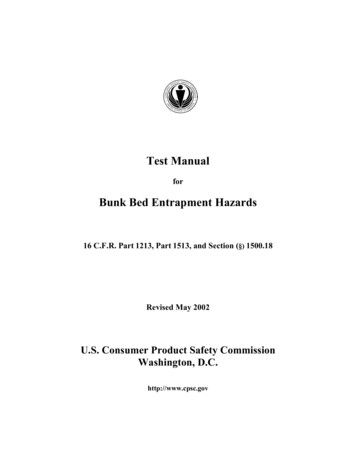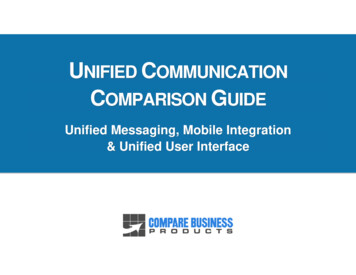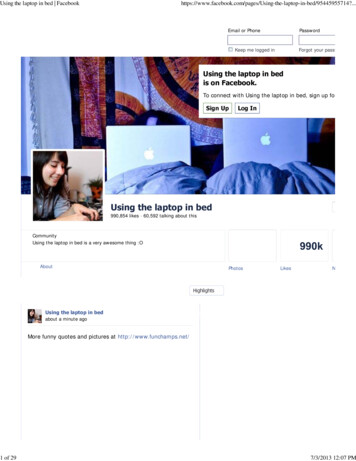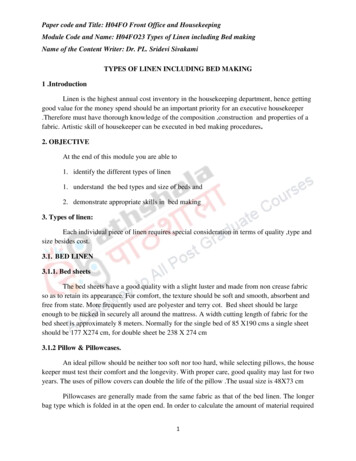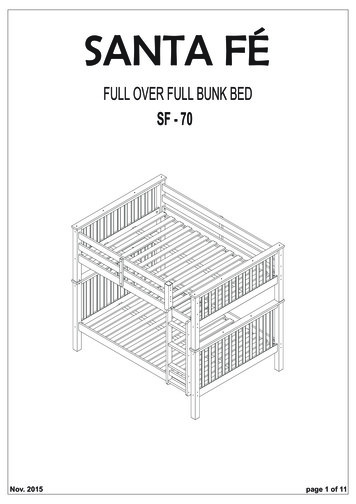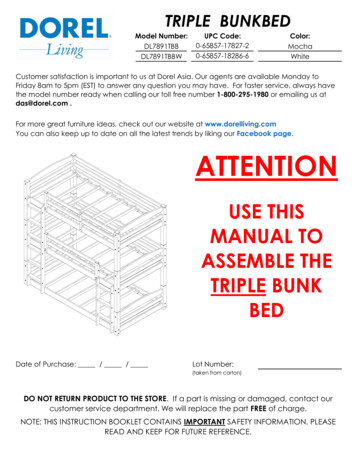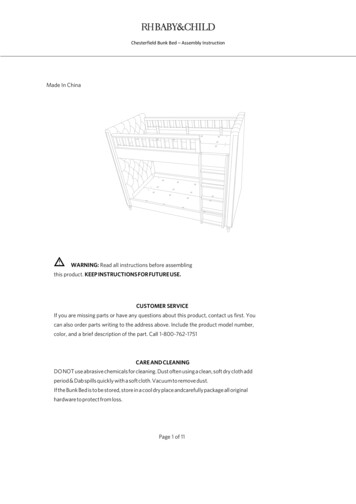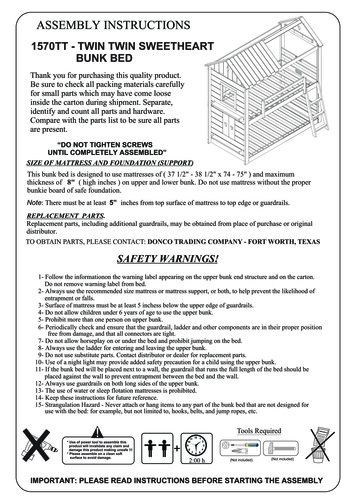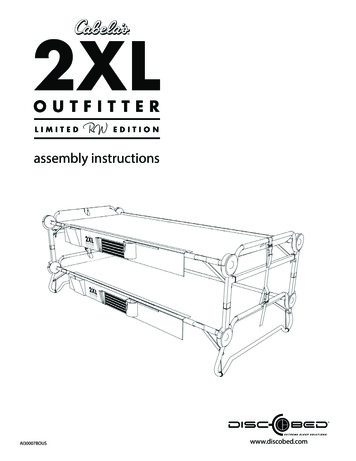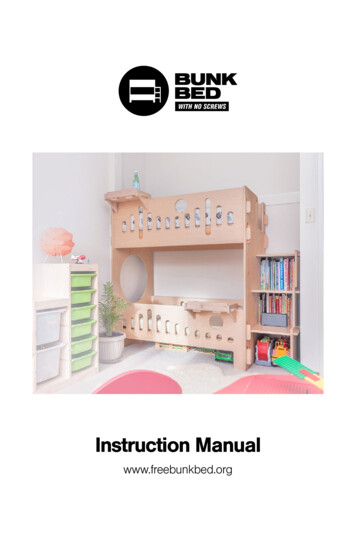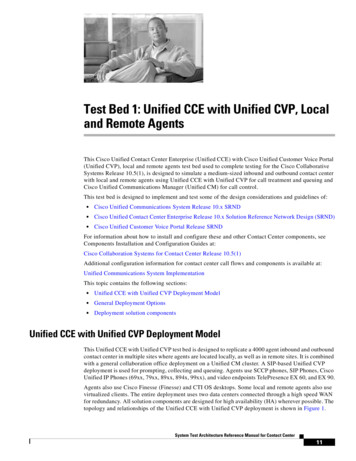
Transcription
Test Bed 1: Unified CCE with Unified CVP, Localand Remote AgentsThis Cisco Unified Contact Center Enterprise (Unified CCE) with Cisco Unified Customer Voice Portal(Unified CVP), local and remote agents test bed used to complete testing for the Cisco CollaborativeSystems Release 10.5(1), is designed to simulate a medium-sized inbound and outbound contact centerwith local and remote agents using Unified CCE with Unified CVP for call treatment and queuing andCisco Unified Communications Manager (Unified CM) for call control.This test bed is designed to implement and test some of the design considerations and guidelines of: Cisco Unified Communications System Release 10.x SRND Cisco Unified Contact Center Enterprise Release 10.x Solution Reference Network Design (SRND) Cisco Unified Customer Voice Portal Release SRNDFor information about how to install and configure these and other Contact Center components, seeComponents Installation and Configuration Guides at:Cisco Collaboration Systems for Contact Center Release 10.5(1)Additional configuration information for contact center call flows and components is available at:Unified Communications System ImplementationThis topic contains the following sections: Unified CCE with Unified CVP Deployment Model General Deployment Options Deployment solution componentsUnified CCE with Unified CVP Deployment ModelThis Unified CCE with Unified CVP test bed is designed to replicate a 4000 agent inbound and outboundcontact center in multiple sites where agents are located locally, as well as in remote sites. It is combinedwith a general collaboration office deployment on a Unified CM cluster. A SIP-based Unified CVPdeployment is used for prompting, collecting and queuing. Agents use SCCP phones, SIP Phones, CiscoUnified IP Phones (69xx, 79xx, 89xx, 894x, 99xx), and video endpoints TelePresence EX 60, and EX 90.Agents also use Cisco Finesse (Finesse) and CTI OS desktops. Some local and remote agents also usevirtualized clients. The entire deployment uses two data centers connected through a high speed WANfor redundancy. All solution components are designed for high availability (HA) wherever possible. Thetopology and relationships of the Unified CCE with Unified CVP deployment is shown in Figure 1.System Test Architecture Reference Manual for Contact Center11
Test Bed 1: Unified CCE with Unified CVP, Local and Remote AgentsFigure 1Unified CCE with Unified CVP test bed topologyGeneral Deployment OptionsThe following deployment options were used for this Unified CCE with Unified CVP test bed.Deployment ModelThe deployment is a Clustering over WAN model. In this deployment, the agents are local and connectedthrough LAN/MAN infrastructure to one side of the Unified CCE deployment. The Unified CCEcomponents and Unified CM components are in a secondary data center, which provides redundancy incase disaster recovery is needed. The two data centers are separated by a WAN.The Clustering over WAN model has the following setup: Unified CCE clustering with two links, one for Unified CCE public and Intra-ClusterCommunication Signaling (ICCS) traffic and one for Unified CCE private traffic. To ensure path diversity, there are separate, dedicated links for Unified CCE private communicationsbetween the Unified CCE Central Controllers on Side A and Side B, and between the peripheralgateways on Side A and Side B. Path diversity is required due to the architecture of Unified CCE.System Test Architecture Reference Manual for Contact Center12
Test Bed 1: Unified CCE with Unified CVP, Local and Remote AgentsRemote Gateway 2 (3925) ISR G2 has two Services Modules (SM) with Services Ready Engine(SM-SRE-910-K9) loaded with Cisco SRE-V Software 2.0.1.0, with MediaSense primary and secondarynodes installed, which are used to record audio calls using Unified CM-based forking and CUBE-basedforking methods.Cisco Unified Contact Center Enterprise and Cisco Unified Intelligent Contact ManagementEnterpriseUnified CCE and Unified ICM, integral components of the Cisco Unified Communications System,provide intelligent routing and call treatment with transparent blending of multiple communicationchannels, while easing the transition from a traditional automatic call distributor (ACD) to an IP-basedACD.Unified CCE/Unified ICM are part of a strategic platform that helps customers move into the next phaseof customer contact, beyond today's contact center to a Customer Interaction Network. The CustomerInteraction Network is a distributed, IP-based customer service infrastructure that comprises acontinuously evolving suite of innovative, multichannel services andcustomer-relationship-management (CRM) applications.Unified CCE/Unified ICM software is deployed at the test sites in the contact center environment. WithUnified CCE/Unified ICM, the call center manager can configure agents to handle inbound andoutbound voice calls. The agents can switch between these media on a task-by-task basis.For the latest configuration options for Cisco Collaboration Systems Release 10.5(1), go ustcosw/ps1844/products installation and configuration guides list.html.Cisco Unified Customer Voice PortalThe Cisco Unified Customer Service Portal (Unified CVP) provides interactive voice response andqueuing capabilities in a contact center environment and supports automated speech recognition (ASR)and text-to-speech (TTS) capabilities. Unified CVP is implemented in this test environment inself-service mode, and the comprehensive mode that includes support for agent queuing, multisite callswitching, and speech-enabled and touch-tone applications. Customers can use touchtone signals or theirown voice to request self-service information. Its components work together to enable you to create anddeploy IVR applications that include voice interaction as well as traditional numeric input to provideintelligent, personalized self-service over the phone.Unified CVP Call Server consists of SIP services and plays media files to the caller and collectsinformation in return. It also interprets messages from Unified ICME and generates VXML documentsthat it uses to route the call.Through an operations console, Unified CVP also provides the ability to monitor, manage, and configureall Unified CVP solution components from a central, single operations console.For additional information about Cisco Unified Customer Service Portal, go /ps1006/tsd products support series home.html.System Test Architecture Reference Manual for Contact Center13
Test Bed 1: Unified CCE with Unified CVP, Local and Remote AgentsCisco Outbound Dialer OptionThe Cisco Outbound Option application provides outbound dialing functionality along with the existinginbound capabilities of Unified CCE. This application enables the contact center to dial customers anddirect contacted customers to agents or IVRs. The Outbound Option Dialer component, which resideson the peripheral gateway server dials customers using Cisco Unified Communications Manager(Unified CM) and voice gateways, reserves agents via the Media Routing (MR) interface and transfersanswered customers calls to reserved agents.In an Outbound Option deployment that uses the SIP Dialer, functions such as dialing, call control, andCall Progress Analysis for Outbound campaigns are handled by the voice gateway, and not by UnifiedCM. This increases the number of outbound agents that a deployment can service on a peripheralgateway, and reduces the number of peripheral gateways and dialers customers need to deploy for largerenterprise systems.For additional information about Cisco Outbound Dialer Option, go /ps524/tsd products support series home.html.Cisco Mobile AgentThe Cisco Mobile Agent feature enables Unified CCE/Unified ICME to support agents using phones notdirectly controlled by Unified CM. This could be an agent: outside the call center, using an analog phone at home or a cell phone inside the call center, using an IP phone connection not controlled by Unified CCE or an associatedUnified CMIf you plan to configure a mobile agent to use: an analog phone or an Cisco Unified IP Phone (Unified IP Phone) without the Cisco Business ReadyTeleworker setup, use the Mobile Agent optionFor all support information for Cisco Mobile Agent, go esw/custcosw/ps5693/ps6223/product data sheet0900aecd80425476.html.Cisco MediaSenseCisco MediaSense (MediaSense) is a SIP-based service that allows other network devices in real-timeto monitor customer conversations, including recording, playback, streaming and storing audio andvideo data, including Video on Hold (VoH) and Video in Queue (ViQ). MediaSense automaticallycaptures and stores every Voice over IP (VoIP) conversation which cross configured UnifiedCommunications Manager IP phones or CUBE devices.MediaSense is an IP media recording and playback system that implements the Open RecordingArchitecture open interfaces. MediaSense comprises of many elements to support IP based recording. Itsolves the topology issues and accelerates the adoption of Cisco Collaboration Systems. It captures,stores, and processes multimedia on a unified network platform, enables contact center supervisors tolive monitor conversations and assist agents in resolving caller issues and provides open, standardizedhooks for real-time speech analytics, to help customer service representatives assist callers faster andmore effectively.For all support information for Cisco MediaSense, go to:System Test Architecture Reference Manual for Contact Center14
Test Bed 1: Unified CCE with Unified CVP, Local and Remote tsd products support series home.html.Cisco FinesseFinesse is a next-generation agent and supervisor desktop designed to provide a collaborative experiencefor the various communities that interact with your customer service organization. In this deployment,Finesse is installed on a virtual machine as a primary and secondary node.Finesse with Cisco Virtualization Experience Media Engine 9.7 (CiscoVXME) was tested with bothCitrix Desktop 7.0and with VMware View. Finesse is installed on the Linux-based Cisco UnifiedCommunication Voice Operating System. Primary and secondary Finesse servers are installed on thesame site as Unified CCE components. Currently Finesse does not support primary and secondary nodesseparated over WAN. Agents can sign on to the Finesse Server from Microsoft Internet Explorer 9.0 orMozilla Firefox version later than 24, using a laptop or a desktop connected directly to the data centeror remotely using Cisco VXC 62xx clients such as VPN using VMware/Citrix View.Agents sign on to the Finesse server from Microsoft Internet Explorer 9.0 either using a laptop or adesktop unit connected directly to the data center, or remotely using virtual desktop infrastructure (VDI)devices.For all support information for Cisco Finesse, go to:http://www.cisco.com/en/US/products/ps11324/tsd products support series home.html.Cisco SocialMinerCisco SocialMiner (SocialMiner) is a social media customer care solution. SocialMiner can help youproactively respond to customers who communicate through public networks. SocialMiner and UnifiedCCE work in concert to process the Agent Request (Voice CallBack) from its inception through thereceipt of the call back.The role of SocialMiner in the Agent Request feature: Provides a notification mechanism (the Connection to CCE notification type) used to forwardcallback requests to UCCE via a Media Routing (MR) connection Provides the API used by custom applications to initiate a callback Forwards the callback details to UCCE Provides an API used by custom applications to retrieve the state of the callback, including a fieldin the GET call that defines the estimated wait time until an agent becomes available that can becommunicated to the end user Provides an API used by custom applications to cancel a requested callbackFor more information about Cisco SocialMiner, go ex.html.Cisco Jabber for WindowsCisco Jabber for Windows streamline communications and enhances productivity through unifiedpresence, instant messaging, and audio conference into one client on your desktop. Built on openstandards, Jabber for Windows integrates with commonly used desktop applications. Jabber forWindows 9.7.1 softphones are installed in data center A, data center B, and remote sites.For all support information for Cisco Jabber for Windows, go to:System Test Architecture Reference Manual for Contact Center15
Test Bed 1: Unified CCE with Unified CVP, Local and Remote t-series-home.html.Cisco Virtual Office and Cisco AnyConnect VPN clientCT IOS and Finesse Agent/phones are connected to the data center through a VPN tunnel.In the Cisco Virtual Office (CVO) case, the VPN tunnel is established from the head-end VPN Hubrouter, which is connected to Data Center side A and terminated at a CVO spoke Router (881 and 891routers), where Agent desktops and phones are connected. In the Cisco AnyConnect Secure MobilityClient case, the VPN tunnel is established from the ASA that is connected to Data Center Side A andterminated at phone models like 79XX, 89XX, and 99XX series, which support the VPN services.For additional information about Cisco Virtual Office, go to:http://www.cisco.com/en/US/netsol/ns855/.For additional information about Cisco Anyconnect VPN client, go to:http://www.cisco.com/en/US/products/ps8411/tsd products support series home.html.Cisco Unified Contact Center Enterprise DesktopThe Cisco Computer Telephony Integration Option (CTI OS) Agent Desktop and the Finesse AgentDesktop are both tested. CTI OS Agent Desktop functionality used during testing includes handling ofinbound calls, outbound calls, transfer and conference. Finesse Agent Desktop testing includes handlingof inbound calls, transfer and conference.For all support information for Cisco Unified Contact Center Enterprise Desktop, go custcosw/ps1844/tsd products support series home.html.For all support information for Cisco Computer Telephony Integration Option, go custcosw/ps14/tsd products support series home.html.Cisco Unified Border ElementSIP trunking is used for the Unified CVP deployment with Cisco IOS gateways and Cisco Unified BorderElement (CUBE). Stand-alone CUBE is placed in data center A and data center B respectively. Fromeach CUBE a SIP trunk is running on Transmission Control Protocol (TCP) (using VoIP dial-peer) toUnified CVP in data center A and data center B respectively. From Unified CVP, a SIP trunk is runningon TCP to CUBE. In addition, from each CUBE (in Data Center A and B), one more SIP trunk is runningon User Datagram Protocol (UDP) (using VoIP Dial-peers) on each CUBE to accept the IP calls from IPPSTN Service Provider network.For further information about Cisco Unified Border Element, go ps5640/tsd products support series home.html.Virtualization supportMany components of the solution are running on virtual machines on Cisco Unified Computing SystemUCS hardware.For further information about Virtualization Support, go to:System Test Architecture Reference Manual for Contact Center16
Test Bed 1: Unified CCE with Unified CVP, Local and Remote .Desktop VirtualizationCisco Virtualization Experience Media Engine 9.7 (Cisco VXME) is deployed in the data center whileThe Cisco Virtualization Experience Client (VXC6215) runs on the local client.The Cisco Virtualization Experience Client (VXC) 6xxx is a thin client that unifies voice, video andvirtual desktops in one device. VXC 6xxx clients were deployed both in the data center as well as remotesites. PCoIP and ICA were tested with VXC 6xxx. Some of the remote clients were over VPN. Both CTIOS Agent Desktop and Finesse were tested with these virtualized clients.For further information about Cisco VXME, go ne/index.html.For further information about Cisco VXC 6000 Series, go 0series/index.html.ConferencingThe Cisco TelePresence Server is an innovative software solution enabling high-quality standards-basedconferencing for the mobile or desktop user and the immersive room meeting participant.Cisco TelePresence Conductor helps ensure simple, reliable, and efficient multiparty telepresence andcollaborative conferencing.Cisco TelePresence MCU 4500 Series (MCU 4501) is a full high-definition multimedia conferencingbridge. MCU 4501 was deployed in the data center and registered to the Unified CM. MCU 4501 waspart of the MRGL configured on all phones so that conferencing initiated can allocate a video conferencebridge.SecuritySecurity components include firewall, antivirus software. Security is implemented at the various sites asfollows: McAfee Antivirus-Third-party antivirus agents are installed on Windows-based servers like UnifiedICME, and others, but not on non-Windows appliances such as Unified CM.System Test Architecture Reference Manual for Contact Center17
Cisco Outbound Dialer Option. The Cisco Outbound Option application provides outbound dialing functionality along with the existing inbound capabilities of Unified CCE. This application enables the contact center to dial customers and direct contacted customers to agents or IVRs. The Outbound Option Dialer component, which resides
